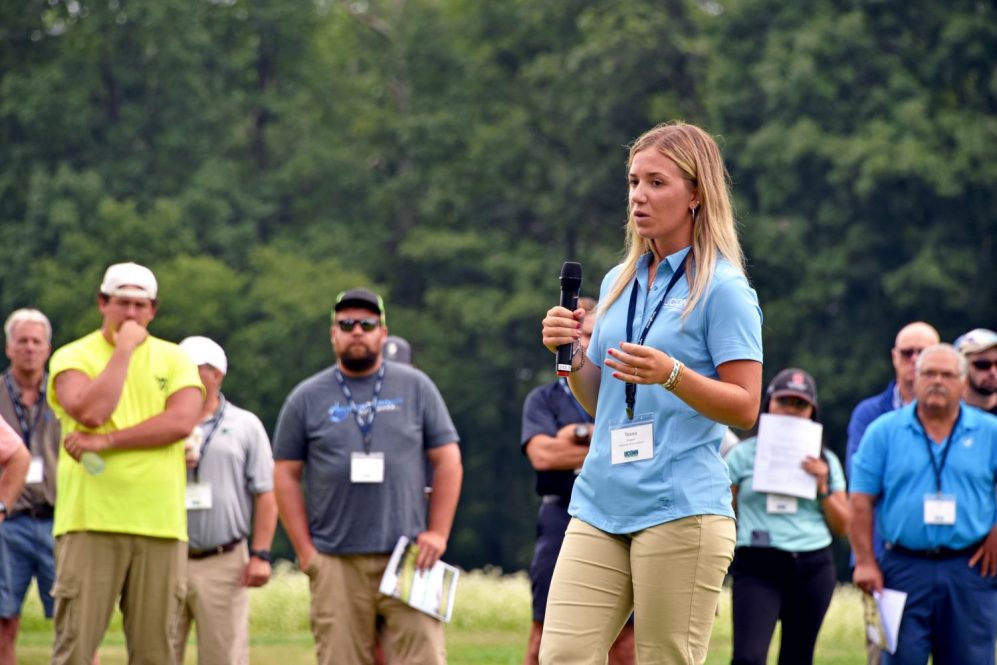From cut quality to fertilizer use, autonomous mowers offer an improved approach to lawncare

Graduate student Tessa Hospod in the Department of Plant Science and Landscape Architecture, speaks with attendees of the 2024 Turfgrass Field Day. (Jason Sheldon/UConn Photo)
Autonomous lawn mowers have been gaining traction in recent years as a cost- and time-saving strategy to combat labor shortages and improve sustainability in the turfgrass industry. They can also make this timely chore easier for homeowners.
Tessa Hospod '24 (CLAS) '26 (CAHNR) is investigating how autonomous mowers impact the agronomic aspects of turfgrass management, including turfgrass quality, mowing quality, and disease incidence for her master's thesis. Hospod is working under Jason Henderson, professor of turfgrass and soil sciences in the Department of Plant Science and Landscape Architecture.
In one early project, Hospod is studying if using autonomous mowers reduces the need to apply fertilizer to turfgrass. Fertilizer inputs are a significant economic and environmental cost for the turfgrass industry.
Already, Hospod has found that for tall fescue grass mowed with autonomous mowers, fertilizer applications last longer than those mowed with conventional machines. The fertilizer they apply in May keeps the grass looking green and healthy well into July or August, which is not observed with conventional mowing.
These preliminary results were published in New England Blade - The New England Sports Turf Managers Association Magazine.
"From a turfgrass management standpoint, if you're able to cut back on fertility treatments while utilizing autonomous mowing, it's cutting back on your resources, time and money spent," Hospod says.
Since they do not need a human operator, autonomous mowers can go out every day, leaving shorter, more frequent piles of clippings which may help the grass stay verdant. In this study, grass under the regular mowing regime is only cut weekly, which also aligns with standard homeowner mowing schedules.
Autonomous mowers produce lower emissions than traditional mowers, providing an added environmental benefit.
These mowers can also operate at night. Hospod is studying this variable as well to see if it impacts the quality of the grass.
In a separate study, Hospod is comparing how varied turfgrass species respond to different heights of cut with autonomous mowers compared to conventional mowing.
So far, two species - Tall Fescue and Kentucky Bluegrass - have shown the best results in terms of quality and color at a cut height of 2.25 inches. The other heights they are testing are 1.25 inches and 3.25 inches.
"The best results we're seeing so far are in that middle range of two to two and a half inches," Hospod says.
Hospod is also comparing the quality of cut from autonomous versus conventional mowers across grass species. A higher-quality cut is less stressful for the plant because it causes less bruising in the leaf tissue, leading to a more attractive, healthier plant.
Traditional lawn mowers have one big blade that rotates as you push. Autonomous mowers have five, much-sharper, small blades on a disk, making the cuts cleaner.
This difference in cut quality may explain why a species like Tall Fescue is demonstrating better outcomes. It is a thicker grass that can be difficult for traditional mowers to cut cleanly, but not autonomous mowers.
This research is steeped in collaboration with industry, a priority throughout UConn's turfgrass program. It is funded by the New England Regional Turfgrass Foundation; Nardella's Turf Care provides technical support; and Husqvarna loaned the autonomous mowers to the researchers.
"Our job as researchers is to take questions that we see in the industry, that different professionals bring to us and incorporate those questions into our research," Hospod says. "Because, I like to say, what is the point of doing research if it's not going to be applied in the real world?"
Hospod says that after she finishes her degree in May, she wants to find a job in the turfgrass industry where she can continue to help turfgrass managers make more informed decisions, whether through continued research or in other ways.
"I think there's a lot to be done," Hospod says. "Autonomous mowing in the turfgrass industry is very new, but it's exploded very quickly and it's exciting to explore the impact it could have."
This work relates to CAHNR's Strategic Vision area focused on Fostering Sustainable Landscapes at the Urban-Rural Interface.






